ENGL 140R: Ontario Education System and Critical Thinking Analysis
VerifiedAdded on 2023/05/30
|8
|1761
|422
Report
AI Summary
This research paper, prepared for an ENGL 140R assignment, investigates the Ontario education system's ability to cultivate critical thinking skills among students, particularly at the post-secondary level. The paper begins with an introduction to the Ontario education system, highlighting its structure and importance. It then poses a research question concerning the effectiveness of the system in preparing students for critical thinking. The paper reviews relevant literature, examining the system's objectives, curriculum, and teaching methods. The findings section presents an analysis of the current curriculum, its strengths, and weaknesses, focusing on how it fosters critical thinking. The study also considers the role of faculty and government initiatives in enhancing the quality of education. The conclusion summarizes the key findings and offers recommendations for improvements, such as incorporating best practices from other countries and providing regular training for teachers. The paper cites multiple sources, adhering to MLA format, and aims to contribute to a better understanding of the Ontario education system and its impact on student outcomes.
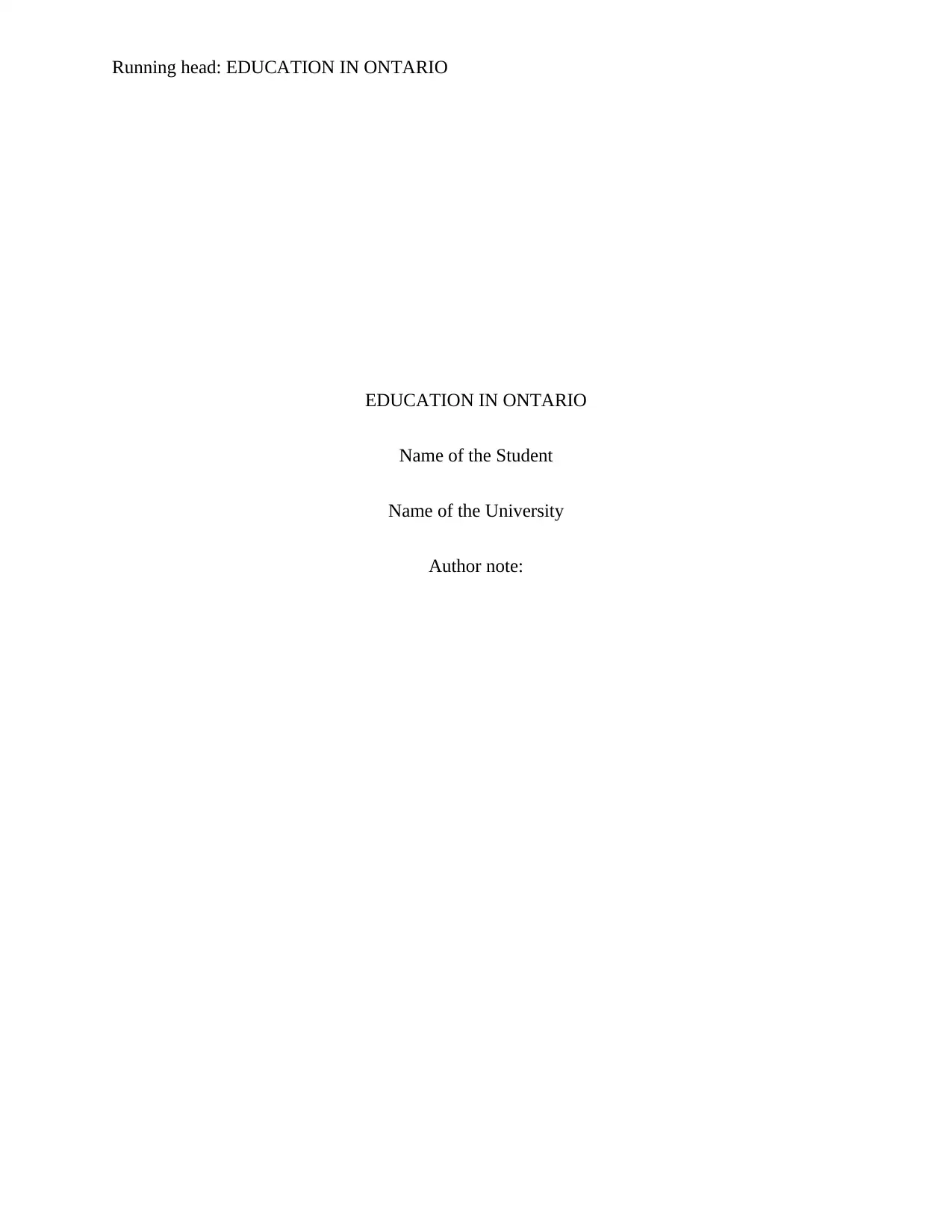
Running head: EDUCATION IN ONTARIO
EDUCATION IN ONTARIO
Name of the Student
Name of the University
Author note:
EDUCATION IN ONTARIO
Name of the Student
Name of the University
Author note:
Paraphrase This Document
Need a fresh take? Get an instant paraphrase of this document with our AI Paraphraser
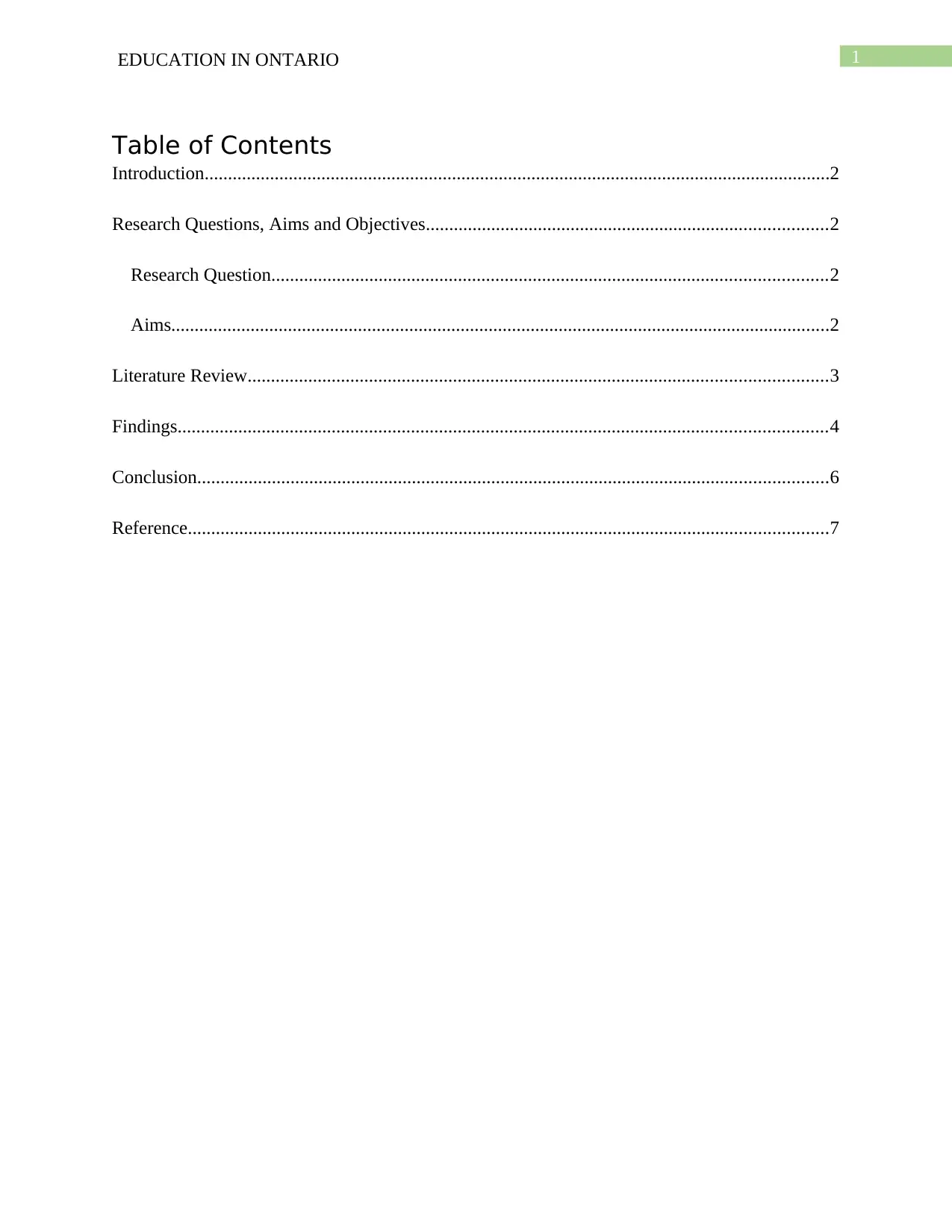
1EDUCATION IN ONTARIO
Table of Contents
Introduction......................................................................................................................................2
Research Questions, Aims and Objectives......................................................................................2
Research Question.......................................................................................................................2
Aims.............................................................................................................................................2
Literature Review............................................................................................................................3
Findings...........................................................................................................................................4
Conclusion.......................................................................................................................................6
Reference.........................................................................................................................................7
Table of Contents
Introduction......................................................................................................................................2
Research Questions, Aims and Objectives......................................................................................2
Research Question.......................................................................................................................2
Aims.............................................................................................................................................2
Literature Review............................................................................................................................3
Findings...........................................................................................................................................4
Conclusion.......................................................................................................................................6
Reference.........................................................................................................................................7
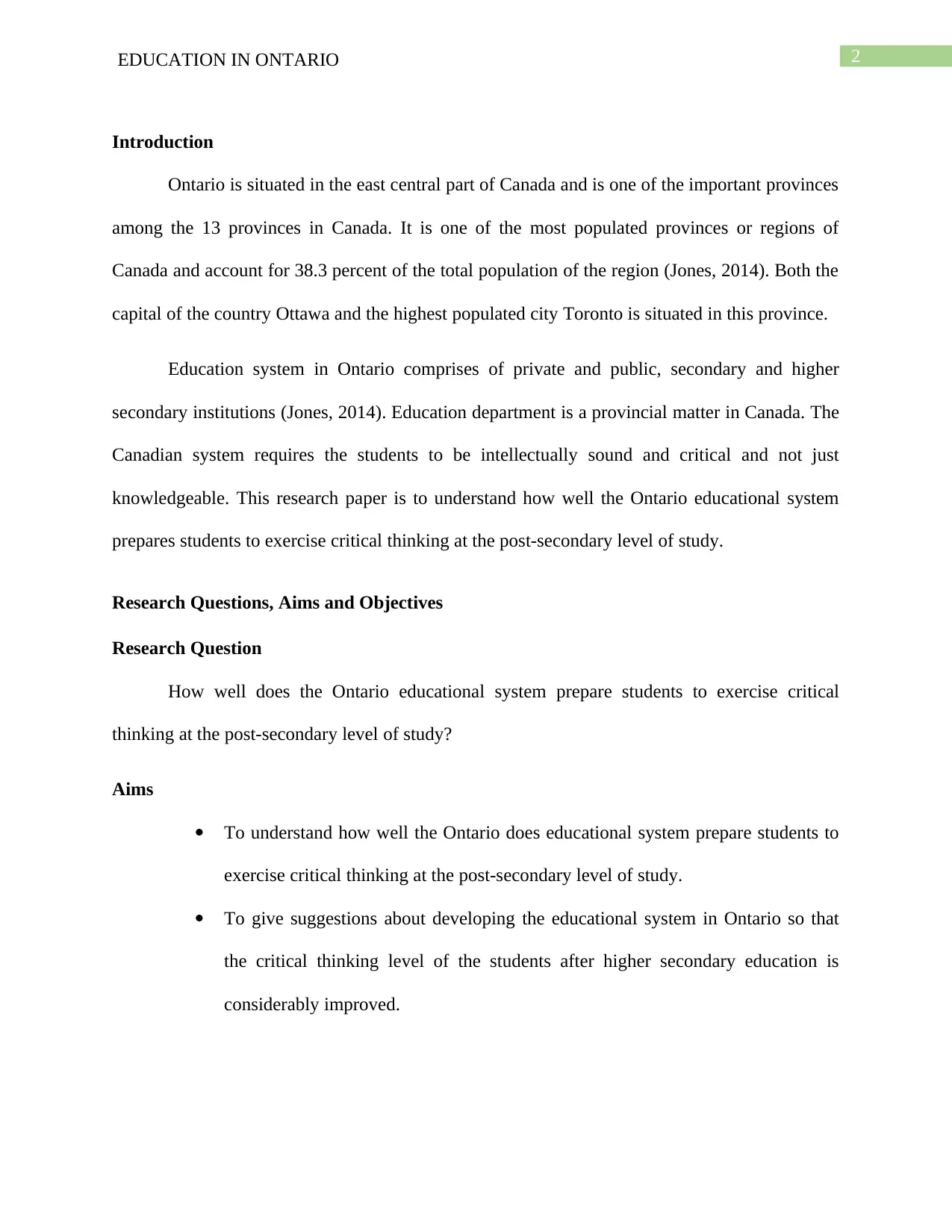
2EDUCATION IN ONTARIO
Introduction
Ontario is situated in the east central part of Canada and is one of the important provinces
among the 13 provinces in Canada. It is one of the most populated provinces or regions of
Canada and account for 38.3 percent of the total population of the region (Jones, 2014). Both the
capital of the country Ottawa and the highest populated city Toronto is situated in this province.
Education system in Ontario comprises of private and public, secondary and higher
secondary institutions (Jones, 2014). Education department is a provincial matter in Canada. The
Canadian system requires the students to be intellectually sound and critical and not just
knowledgeable. This research paper is to understand how well the Ontario educational system
prepares students to exercise critical thinking at the post-secondary level of study.
Research Questions, Aims and Objectives
Research Question
How well does the Ontario educational system prepare students to exercise critical
thinking at the post-secondary level of study?
Aims
To understand how well the Ontario does educational system prepare students to
exercise critical thinking at the post-secondary level of study.
To give suggestions about developing the educational system in Ontario so that
the critical thinking level of the students after higher secondary education is
considerably improved.
Introduction
Ontario is situated in the east central part of Canada and is one of the important provinces
among the 13 provinces in Canada. It is one of the most populated provinces or regions of
Canada and account for 38.3 percent of the total population of the region (Jones, 2014). Both the
capital of the country Ottawa and the highest populated city Toronto is situated in this province.
Education system in Ontario comprises of private and public, secondary and higher
secondary institutions (Jones, 2014). Education department is a provincial matter in Canada. The
Canadian system requires the students to be intellectually sound and critical and not just
knowledgeable. This research paper is to understand how well the Ontario educational system
prepares students to exercise critical thinking at the post-secondary level of study.
Research Questions, Aims and Objectives
Research Question
How well does the Ontario educational system prepare students to exercise critical
thinking at the post-secondary level of study?
Aims
To understand how well the Ontario does educational system prepare students to
exercise critical thinking at the post-secondary level of study.
To give suggestions about developing the educational system in Ontario so that
the critical thinking level of the students after higher secondary education is
considerably improved.
⊘ This is a preview!⊘
Do you want full access?
Subscribe today to unlock all pages.

Trusted by 1+ million students worldwide
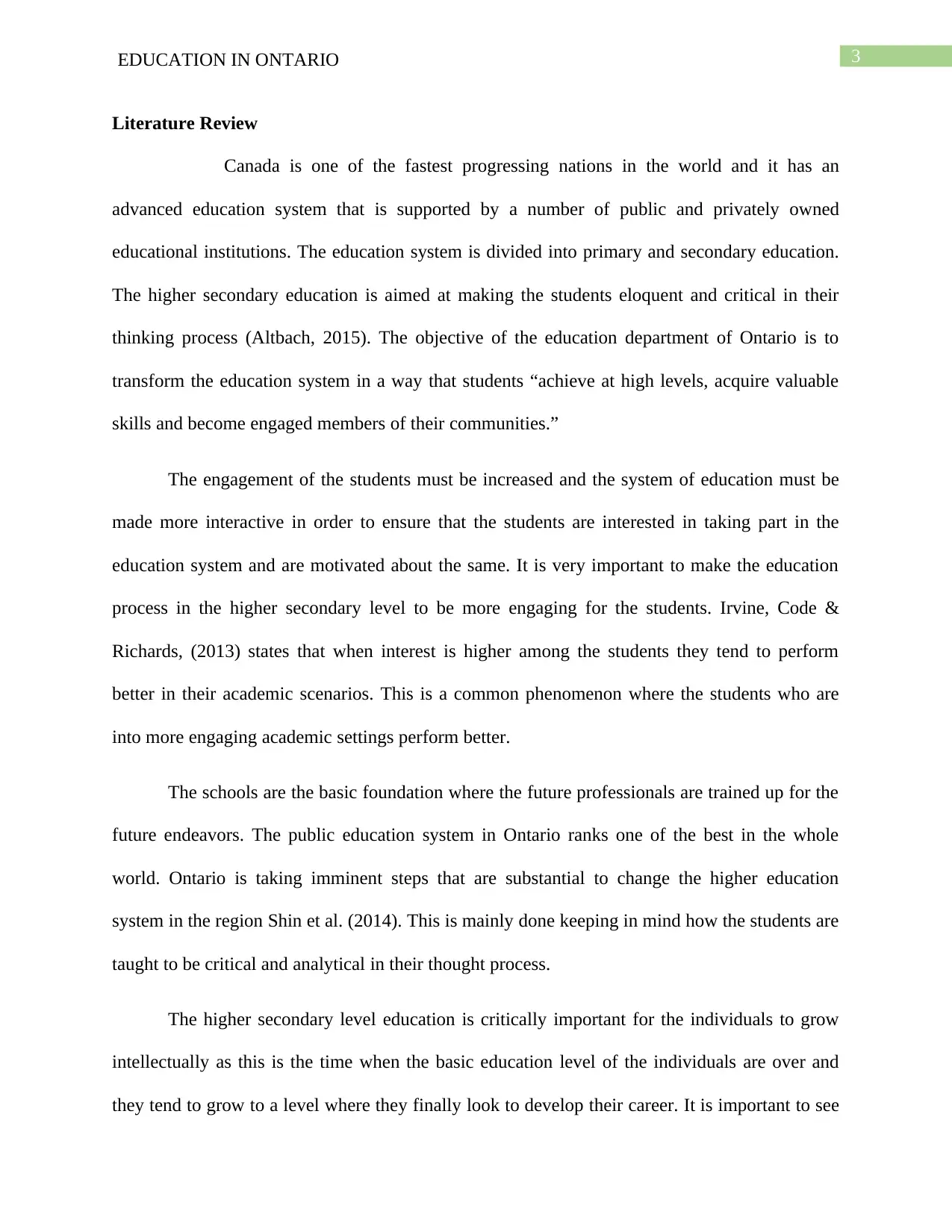
3EDUCATION IN ONTARIO
Literature Review
Canada is one of the fastest progressing nations in the world and it has an
advanced education system that is supported by a number of public and privately owned
educational institutions. The education system is divided into primary and secondary education.
The higher secondary education is aimed at making the students eloquent and critical in their
thinking process (Altbach, 2015). The objective of the education department of Ontario is to
transform the education system in a way that students “achieve at high levels, acquire valuable
skills and become engaged members of their communities.”
The engagement of the students must be increased and the system of education must be
made more interactive in order to ensure that the students are interested in taking part in the
education system and are motivated about the same. It is very important to make the education
process in the higher secondary level to be more engaging for the students. Irvine, Code &
Richards, (2013) states that when interest is higher among the students they tend to perform
better in their academic scenarios. This is a common phenomenon where the students who are
into more engaging academic settings perform better.
The schools are the basic foundation where the future professionals are trained up for the
future endeavors. The public education system in Ontario ranks one of the best in the whole
world. Ontario is taking imminent steps that are substantial to change the higher education
system in the region Shin et al. (2014). This is mainly done keeping in mind how the students are
taught to be critical and analytical in their thought process.
The higher secondary level education is critically important for the individuals to grow
intellectually as this is the time when the basic education level of the individuals are over and
they tend to grow to a level where they finally look to develop their career. It is important to see
Literature Review
Canada is one of the fastest progressing nations in the world and it has an
advanced education system that is supported by a number of public and privately owned
educational institutions. The education system is divided into primary and secondary education.
The higher secondary education is aimed at making the students eloquent and critical in their
thinking process (Altbach, 2015). The objective of the education department of Ontario is to
transform the education system in a way that students “achieve at high levels, acquire valuable
skills and become engaged members of their communities.”
The engagement of the students must be increased and the system of education must be
made more interactive in order to ensure that the students are interested in taking part in the
education system and are motivated about the same. It is very important to make the education
process in the higher secondary level to be more engaging for the students. Irvine, Code &
Richards, (2013) states that when interest is higher among the students they tend to perform
better in their academic scenarios. This is a common phenomenon where the students who are
into more engaging academic settings perform better.
The schools are the basic foundation where the future professionals are trained up for the
future endeavors. The public education system in Ontario ranks one of the best in the whole
world. Ontario is taking imminent steps that are substantial to change the higher education
system in the region Shin et al. (2014). This is mainly done keeping in mind how the students are
taught to be critical and analytical in their thought process.
The higher secondary level education is critically important for the individuals to grow
intellectually as this is the time when the basic education level of the individuals are over and
they tend to grow to a level where they finally look to develop their career. It is important to see
Paraphrase This Document
Need a fresh take? Get an instant paraphrase of this document with our AI Paraphraser
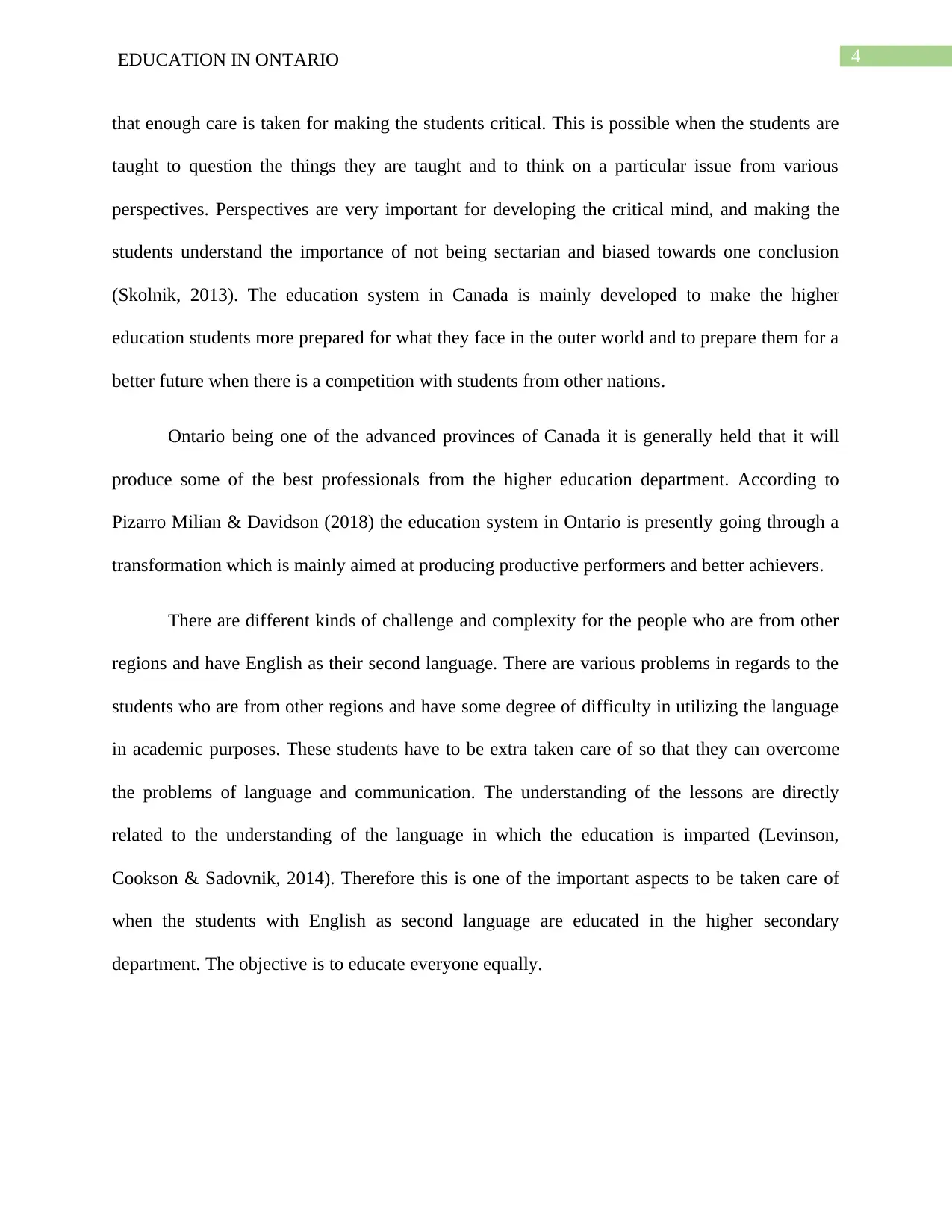
4EDUCATION IN ONTARIO
that enough care is taken for making the students critical. This is possible when the students are
taught to question the things they are taught and to think on a particular issue from various
perspectives. Perspectives are very important for developing the critical mind, and making the
students understand the importance of not being sectarian and biased towards one conclusion
(Skolnik, 2013). The education system in Canada is mainly developed to make the higher
education students more prepared for what they face in the outer world and to prepare them for a
better future when there is a competition with students from other nations.
Ontario being one of the advanced provinces of Canada it is generally held that it will
produce some of the best professionals from the higher education department. According to
Pizarro Milian & Davidson (2018) the education system in Ontario is presently going through a
transformation which is mainly aimed at producing productive performers and better achievers.
There are different kinds of challenge and complexity for the people who are from other
regions and have English as their second language. There are various problems in regards to the
students who are from other regions and have some degree of difficulty in utilizing the language
in academic purposes. These students have to be extra taken care of so that they can overcome
the problems of language and communication. The understanding of the lessons are directly
related to the understanding of the language in which the education is imparted (Levinson,
Cookson & Sadovnik, 2014). Therefore this is one of the important aspects to be taken care of
when the students with English as second language are educated in the higher secondary
department. The objective is to educate everyone equally.
that enough care is taken for making the students critical. This is possible when the students are
taught to question the things they are taught and to think on a particular issue from various
perspectives. Perspectives are very important for developing the critical mind, and making the
students understand the importance of not being sectarian and biased towards one conclusion
(Skolnik, 2013). The education system in Canada is mainly developed to make the higher
education students more prepared for what they face in the outer world and to prepare them for a
better future when there is a competition with students from other nations.
Ontario being one of the advanced provinces of Canada it is generally held that it will
produce some of the best professionals from the higher education department. According to
Pizarro Milian & Davidson (2018) the education system in Ontario is presently going through a
transformation which is mainly aimed at producing productive performers and better achievers.
There are different kinds of challenge and complexity for the people who are from other
regions and have English as their second language. There are various problems in regards to the
students who are from other regions and have some degree of difficulty in utilizing the language
in academic purposes. These students have to be extra taken care of so that they can overcome
the problems of language and communication. The understanding of the lessons are directly
related to the understanding of the language in which the education is imparted (Levinson,
Cookson & Sadovnik, 2014). Therefore this is one of the important aspects to be taken care of
when the students with English as second language are educated in the higher secondary
department. The objective is to educate everyone equally.
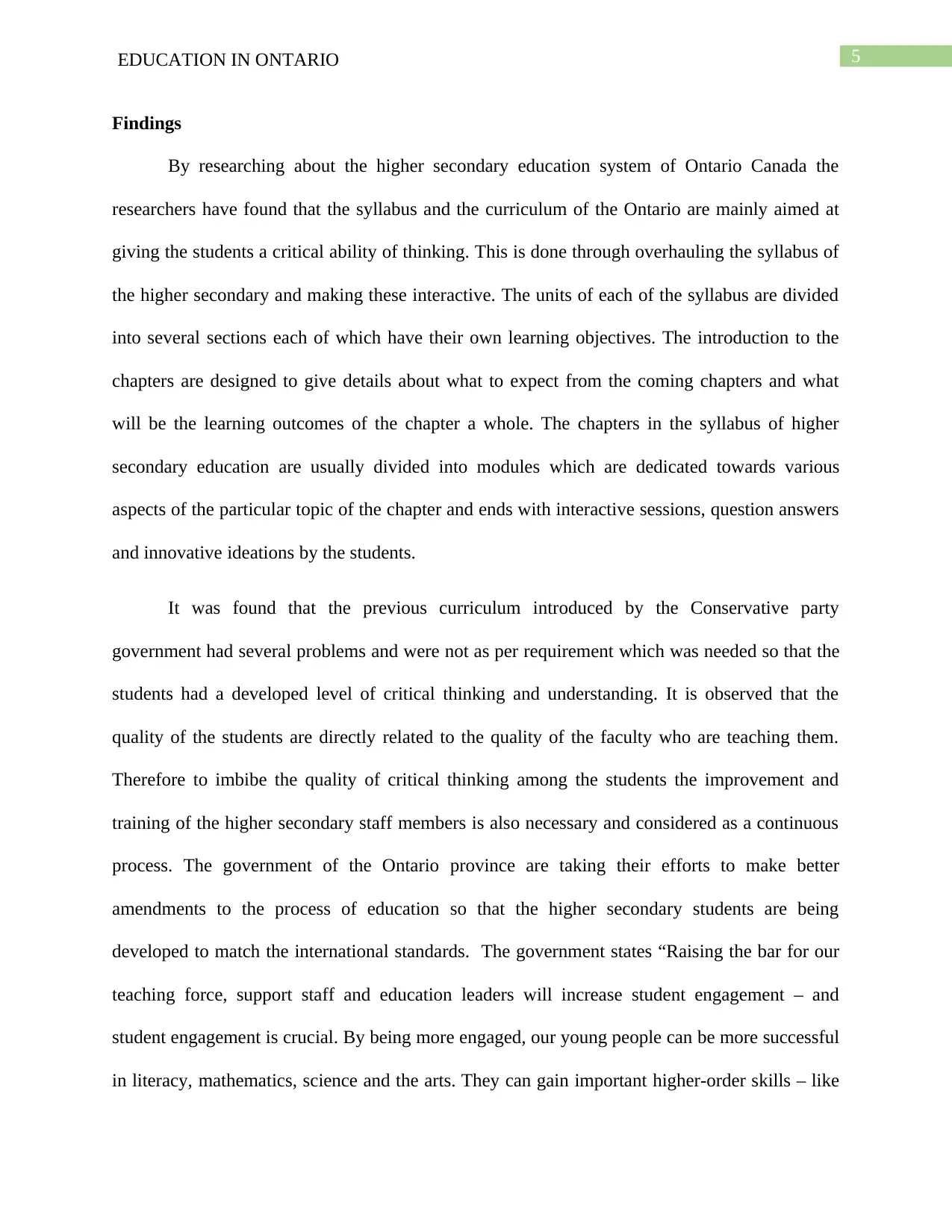
5EDUCATION IN ONTARIO
Findings
By researching about the higher secondary education system of Ontario Canada the
researchers have found that the syllabus and the curriculum of the Ontario are mainly aimed at
giving the students a critical ability of thinking. This is done through overhauling the syllabus of
the higher secondary and making these interactive. The units of each of the syllabus are divided
into several sections each of which have their own learning objectives. The introduction to the
chapters are designed to give details about what to expect from the coming chapters and what
will be the learning outcomes of the chapter a whole. The chapters in the syllabus of higher
secondary education are usually divided into modules which are dedicated towards various
aspects of the particular topic of the chapter and ends with interactive sessions, question answers
and innovative ideations by the students.
It was found that the previous curriculum introduced by the Conservative party
government had several problems and were not as per requirement which was needed so that the
students had a developed level of critical thinking and understanding. It is observed that the
quality of the students are directly related to the quality of the faculty who are teaching them.
Therefore to imbibe the quality of critical thinking among the students the improvement and
training of the higher secondary staff members is also necessary and considered as a continuous
process. The government of the Ontario province are taking their efforts to make better
amendments to the process of education so that the higher secondary students are being
developed to match the international standards. The government states “Raising the bar for our
teaching force, support staff and education leaders will increase student engagement – and
student engagement is crucial. By being more engaged, our young people can be more successful
in literacy, mathematics, science and the arts. They can gain important higher-order skills – like
Findings
By researching about the higher secondary education system of Ontario Canada the
researchers have found that the syllabus and the curriculum of the Ontario are mainly aimed at
giving the students a critical ability of thinking. This is done through overhauling the syllabus of
the higher secondary and making these interactive. The units of each of the syllabus are divided
into several sections each of which have their own learning objectives. The introduction to the
chapters are designed to give details about what to expect from the coming chapters and what
will be the learning outcomes of the chapter a whole. The chapters in the syllabus of higher
secondary education are usually divided into modules which are dedicated towards various
aspects of the particular topic of the chapter and ends with interactive sessions, question answers
and innovative ideations by the students.
It was found that the previous curriculum introduced by the Conservative party
government had several problems and were not as per requirement which was needed so that the
students had a developed level of critical thinking and understanding. It is observed that the
quality of the students are directly related to the quality of the faculty who are teaching them.
Therefore to imbibe the quality of critical thinking among the students the improvement and
training of the higher secondary staff members is also necessary and considered as a continuous
process. The government of the Ontario province are taking their efforts to make better
amendments to the process of education so that the higher secondary students are being
developed to match the international standards. The government states “Raising the bar for our
teaching force, support staff and education leaders will increase student engagement – and
student engagement is crucial. By being more engaged, our young people can be more successful
in literacy, mathematics, science and the arts. They can gain important higher-order skills – like
⊘ This is a preview!⊘
Do you want full access?
Subscribe today to unlock all pages.

Trusted by 1+ million students worldwide
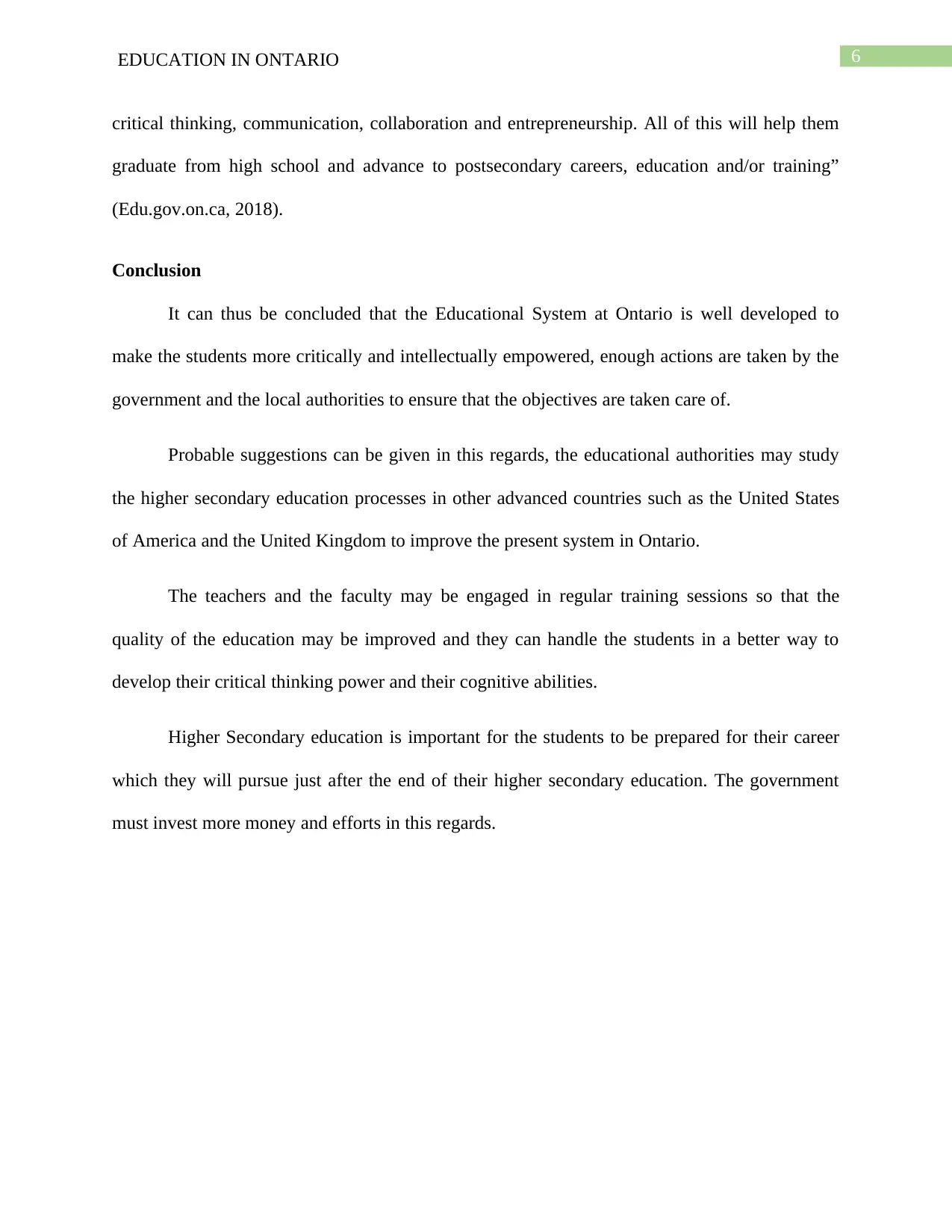
6EDUCATION IN ONTARIO
critical thinking, communication, collaboration and entrepreneurship. All of this will help them
graduate from high school and advance to postsecondary careers, education and/or training”
(Edu.gov.on.ca, 2018).
Conclusion
It can thus be concluded that the Educational System at Ontario is well developed to
make the students more critically and intellectually empowered, enough actions are taken by the
government and the local authorities to ensure that the objectives are taken care of.
Probable suggestions can be given in this regards, the educational authorities may study
the higher secondary education processes in other advanced countries such as the United States
of America and the United Kingdom to improve the present system in Ontario.
The teachers and the faculty may be engaged in regular training sessions so that the
quality of the education may be improved and they can handle the students in a better way to
develop their critical thinking power and their cognitive abilities.
Higher Secondary education is important for the students to be prepared for their career
which they will pursue just after the end of their higher secondary education. The government
must invest more money and efforts in this regards.
critical thinking, communication, collaboration and entrepreneurship. All of this will help them
graduate from high school and advance to postsecondary careers, education and/or training”
(Edu.gov.on.ca, 2018).
Conclusion
It can thus be concluded that the Educational System at Ontario is well developed to
make the students more critically and intellectually empowered, enough actions are taken by the
government and the local authorities to ensure that the objectives are taken care of.
Probable suggestions can be given in this regards, the educational authorities may study
the higher secondary education processes in other advanced countries such as the United States
of America and the United Kingdom to improve the present system in Ontario.
The teachers and the faculty may be engaged in regular training sessions so that the
quality of the education may be improved and they can handle the students in a better way to
develop their critical thinking power and their cognitive abilities.
Higher Secondary education is important for the students to be prepared for their career
which they will pursue just after the end of their higher secondary education. The government
must invest more money and efforts in this regards.
Paraphrase This Document
Need a fresh take? Get an instant paraphrase of this document with our AI Paraphraser
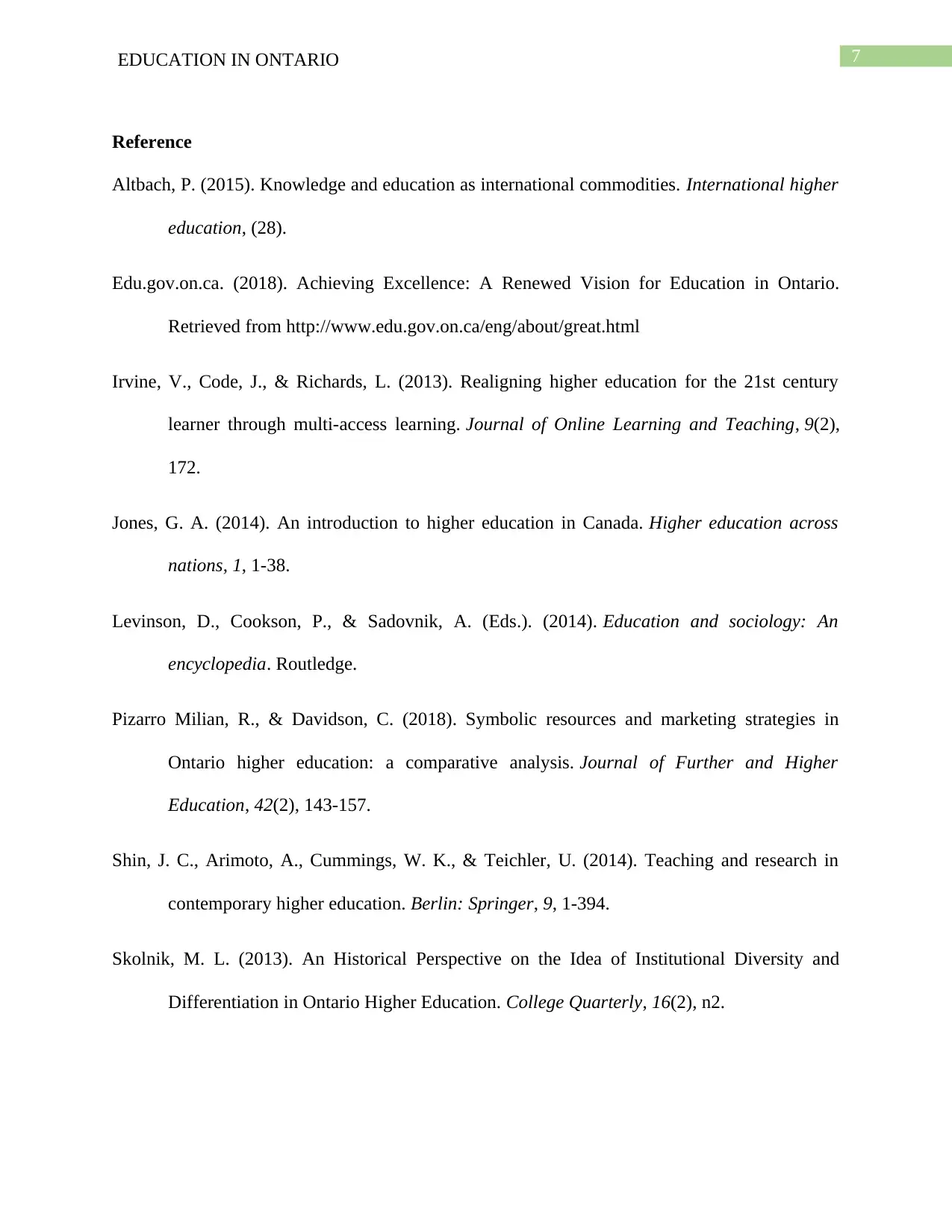
7EDUCATION IN ONTARIO
Reference
Altbach, P. (2015). Knowledge and education as international commodities. International higher
education, (28).
Edu.gov.on.ca. (2018). Achieving Excellence: A Renewed Vision for Education in Ontario.
Retrieved from http://www.edu.gov.on.ca/eng/about/great.html
Irvine, V., Code, J., & Richards, L. (2013). Realigning higher education for the 21st century
learner through multi-access learning. Journal of Online Learning and Teaching, 9(2),
172.
Jones, G. A. (2014). An introduction to higher education in Canada. Higher education across
nations, 1, 1-38.
Levinson, D., Cookson, P., & Sadovnik, A. (Eds.). (2014). Education and sociology: An
encyclopedia. Routledge.
Pizarro Milian, R., & Davidson, C. (2018). Symbolic resources and marketing strategies in
Ontario higher education: a comparative analysis. Journal of Further and Higher
Education, 42(2), 143-157.
Shin, J. C., Arimoto, A., Cummings, W. K., & Teichler, U. (2014). Teaching and research in
contemporary higher education. Berlin: Springer, 9, 1-394.
Skolnik, M. L. (2013). An Historical Perspective on the Idea of Institutional Diversity and
Differentiation in Ontario Higher Education. College Quarterly, 16(2), n2.
Reference
Altbach, P. (2015). Knowledge and education as international commodities. International higher
education, (28).
Edu.gov.on.ca. (2018). Achieving Excellence: A Renewed Vision for Education in Ontario.
Retrieved from http://www.edu.gov.on.ca/eng/about/great.html
Irvine, V., Code, J., & Richards, L. (2013). Realigning higher education for the 21st century
learner through multi-access learning. Journal of Online Learning and Teaching, 9(2),
172.
Jones, G. A. (2014). An introduction to higher education in Canada. Higher education across
nations, 1, 1-38.
Levinson, D., Cookson, P., & Sadovnik, A. (Eds.). (2014). Education and sociology: An
encyclopedia. Routledge.
Pizarro Milian, R., & Davidson, C. (2018). Symbolic resources and marketing strategies in
Ontario higher education: a comparative analysis. Journal of Further and Higher
Education, 42(2), 143-157.
Shin, J. C., Arimoto, A., Cummings, W. K., & Teichler, U. (2014). Teaching and research in
contemporary higher education. Berlin: Springer, 9, 1-394.
Skolnik, M. L. (2013). An Historical Perspective on the Idea of Institutional Diversity and
Differentiation in Ontario Higher Education. College Quarterly, 16(2), n2.
1 out of 8
Related Documents
Your All-in-One AI-Powered Toolkit for Academic Success.
+13062052269
info@desklib.com
Available 24*7 on WhatsApp / Email
![[object Object]](/_next/static/media/star-bottom.7253800d.svg)
Unlock your academic potential
Copyright © 2020–2025 A2Z Services. All Rights Reserved. Developed and managed by ZUCOL.





